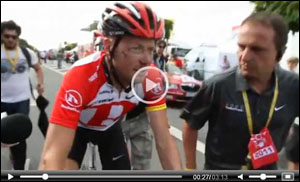On July 8, 2011, thousands of fans logged on to YouTube to watch Chris Horner cross the finish line following Stage 7 of the Tour de France, repeatedly asking "Where am I? Did I finish?" when he couldn't remember crashing 35 kilometers earlier. Many fans could probably guess that Horner, who suffered a massive blow to the head in a multi-rider pileup, had a concussion. It is a matter of grit and perseverance that a rider climbs back on his or her bike and chases the peloton after a crash, if it is physically possible to do so. In cycling, post-crash management is generally conflicted and flawed. Unlike other professional sports, cyclists do not get a time out. There are no sidelines. The moment the rider is down, the peloton speeds away.

"Experts in the field of concussion started to recognize the potential long term implications of even a single concussion and we are now making amazing efforts to provide education about the seriousness of these injuries to athletes, parents, family members, coaches, etc." explained Dr. Jason Brayley, sports medicine physician with MultiCare Orthopedics and Sports Medicine in Puyallup, Wash. "Oftentimes concussions are not recognized by athletes or those people around concussed athletes because they are not dramatic. Concussion symptoms can evolve slowly over hours to days and an athlete may not really understand what they are going through. Concussive injuries often do not involve bleeding lacerations, loss of consciousness, or other startling findings that typically earn immediate medical evaluation."
Dr. Brayley, who is the team physician for Kenda/5-Hour Energy Pro Cycling presented by GearGrinder, has experience managing athletes who have sustained a concussion and can attest to the need for greater knowledge of traumatic brain injuries (TBI). As one of the founding members of a concussion task force, which emerged during last year's inaugural Medicine of Cycling Conference, his goal was to try and correlate current practices in concussion management specifically to the world of cycling, as the sport of cycling has its own set of issues that can make safe evaluation and returning to racing difficult. Led by conference co-chair Dr. Anna K. Abramson of the University of California, San Francisco and co-founder of Medicine of Cycling, members published a concussion statement to educate cycling team managers, coaches and athletes on the symptoms and management of concussion in athletes.

"Concussed cyclists are more likely to have impaired function that leads to a repeat crash, potentially hurting themselves and others," said Dr. Abramson. "We are drawing on the concussion work in other sports to tailor education and guidelines that make sense for cycling because no one wants to see more athletes end their careers or worse because of poor decisions. We know that those with previous concussions are at increased risk of repeat concussions and brain injury, and are most susceptible during the post-concussion period. We want athletes and coaches to know when it's simply too dangerous for a cyclist to get back on the bike."
TBIs rank as the most serious injuries of the half-million emergency room visits recorded by cyclists each year in the US. What makes Horner's case so astonishing - and a string of similar cases reported from the start of the 2011 racing season until now - is the video footage that makes it impossible to ignore the risk of returning to competition that could have led to life-threatening circumstances and/or lasting brain injury for Horner.
In 2006, Zachery Lystedt, a middle school football player from Maple Valley, Wash., was allowed back in the game after suffering a head injury. He later collapsed and was rushed to the hospital where he endured two emergency brain surgeries. Among other elements of his recovery, he's had to learn how to walk again. Now there's a law in Lystedt's name, which requires any athlete to consult a licensed medical professional if there's an apparent injury. Cyclists can significantly decrease their odds of head and skull injury by wearing helmets but, by requiring cyclists to be assessed by medical staff immediately after a crash, far worse problems can be avoided.
Another measure recommended by Medicine of Cycling physicians is to obtain an assessment of athletes' baseline neurologic function because having that information would allow for accurate diagnosis in case of future injury. Knowing an athlete's respective baseline neurologic function is one of the most important aspects of good neurological care for all athletes. Cyclists with a history of prior concussion are at an increased risk of repeat injury, so it is particularly imperative for these athletes to have a baseline cognitive assessment. USA Cycling, the sport's national governing body, has already taken the initiative to test some of its BMX athletes, which signals an emerging trend in both increased awareness of concussions and improved safety for cycling athletes.

Comments are closed.